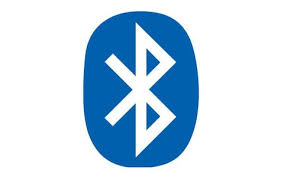Bluetooth
Bluetooth is a wireless technology standard for exchanging data over short distances (using short-wavelength UHF radio waves in the ISM band from 2.4 to 2.485 GHz) from fixed and mobile devices, and building personal area networks (PANs). Invented by Dutch electrical engineer Jaap Haartsen, working for telecom vendor Ericsson in 1994, it was originally conceived as a wireless alternative to RS-232 data cables.
Bluetooth is managed by the Bluetooth Special Interest Group (SIG), which has more than 30,000 member companies in the areas of telecommunication, computing, networking, and consumer electronics.The IEEE standardized Bluetooth as IEEE 802.15.1, but no longer maintains the standard. The Bluetooth SIG oversees development of the specification, manages the qualification program, and protects the trademarks. A manufacturer must meet Bluetooth SIG standards to market it as a Bluetooth device. A network of patents apply to the technology, which are licensed to individual qualifying devices.
Origin
The development of the "short-link" radio technology, later named Bluetooth, was initiated in 1989 by Nils Rydbeck, CTO at Ericsson Mobile in Lund, Sweden and by Johan Ullman. The purpose was to develop wireless headsets, according to two inventions by Johan Ullman, SE 8902098-6, issued 1989-06-12 and SE 9202239, issued 1992-07-24. Nils Rydbeck tasked Tord Wingren with specifying and Jaap Haartsen and Sven Mattisson with developing. Both were working for Ericsson in Lund.The specification is based on frequency-hopping spread spectrum technology.Bluetooth profile
To use Bluetooth wireless technology, a device must be able to interpret certain Bluetooth profiles, which are definitions of possible applications and specify general behaviors that Bluetooth-enabled devices use to communicate with other Bluetooth devices. These profiles include settings to parameterize and to control the communication from the start. Adherence to profiles saves the time for transmitting the parameters anew before the bi-directional link becomes effective. There are a wide range of Bluetooth profiles that describe many different types of applications or use cases for devices.List of applications
- Wireless control and communication between a mobile phone and a handsfree headset. This was one of the earliest applications to become popular.
- Wireless control of and communication between a mobile phone and a Bluetooth compatible car stereo system.
- Wireless control of and communication with iOS and Android device phones, tablets and portable wireless speakers.
- Wireless Bluetooth headset and Intercom. Idiomatically, a headset is sometimes called "a Bluetooth".
- Wireless streaming of audio to headphones with or without communication capabilities.
- Wireless streaming of data collected by Bluetooth-enabled fitness devices to phone or PC.
- Wireless networking between PCs in a confined space and where little bandwidth is required.
- Wireless communication with PC input and output devices, the most common being the mouse, keyboard and printer.
- Transfer of files, contact details, calendar appointments, and reminders between devices with OBEX.
- Replacement of previous wired RS-232 serial communications in test equipment, GPS receivers, medical equipment, bar code scanners, and traffic control devices.
- For controls where infrared was often used.
- For low bandwidth applications where higher USB bandwidth is not required and cable-free connection desired.
- Sending small advertisements from Bluetooth-enabled advertising hoardings to other, discoverable, Bluetooth devices.
- Wireless bridge between two Industrial Ethernet (e.g., PROFINET) networks.
- Seventh and eighth generation game consoles such as Nintendo's Wii, and Sony's PlayStation 3 use Bluetooth for their respective wireless controllers.
- Dial-up internet access on personal computers or PDAs using a data-capable mobile phone as a wireless modem.
- Short-range transmission of health sensor data from medical devices to mobile phone, set-top box or dedicated telehealth devices.Allowing a DECT phone to ring and answer calls on behalf of a nearby mobile phone.
- Real-time location systems (RTLS) are used to track and identify the location of objects in real time using "Nodes" or "tags" attached to, or embedded in, the objects tracked, and "Readers" that receive and process the wireless signals from these tags to determine their locations.
- Personal security application on mobile phones for prevention of theft or loss of items. The protected item has a Bluetooth marker (e.g., a tag) that is in constant communication with the phone. If the connection is broken (the marker is out of range of the phone) then an alarm is raised. This can also be used as a man overboard alarm. A product using this technology has been available since 2009.
- Calgary, Alberta, Canada's Roads Traffic division uses data collected from travelers' Bluetooth devices to predict travel times and road congestion for motorists.
- Wireless transmission of audio (a more reliable alternative to FM transmitters)
- Live video streaming to the visual cortical implant device by Nabeel Fattah in Newcastle university 2017.


Comments
Post a Comment